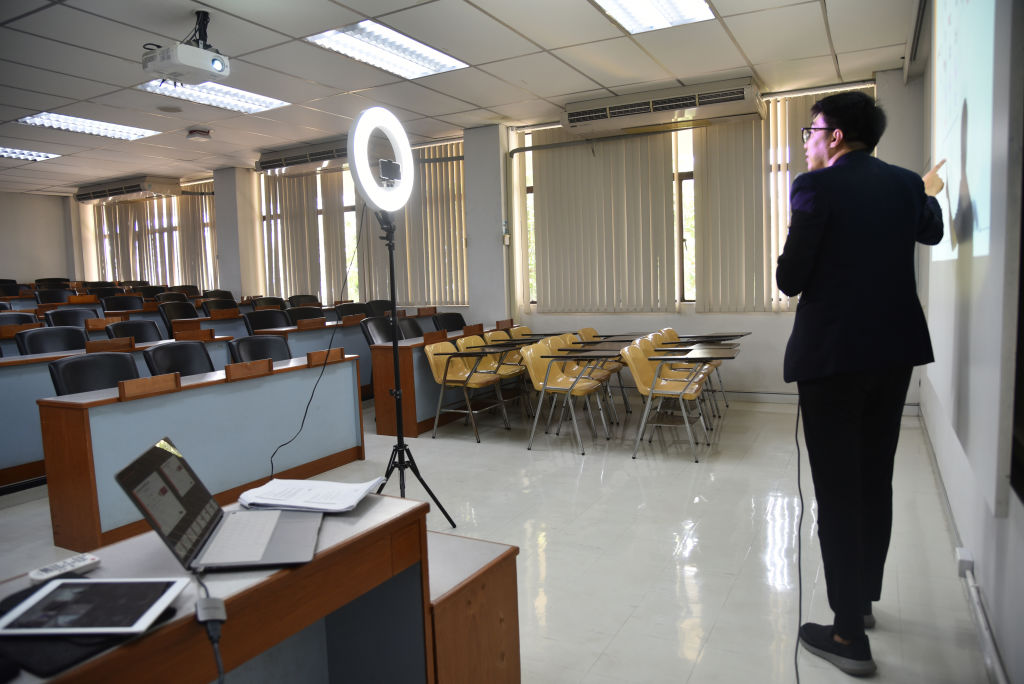It’s 2021, and user expectations and the overall engagement of technology have shifted. When looking at how education and business markets have been impacted by 2020’s pandemic and evolution of technology, there are many similarities between these two environments’ new work patterns: learning strategies and collaborative tools. The landscape of engagement, communication, and collaboration has forever changed—and, we can safely say it has changed for the better.
Technology is finally being recognized as a building utility, and no longer considered an amenity. Technology is now a must-have, and is expected by students and staff alike across educational facilities and corporate environments. The expectation is that untethered access is available everywhere at any time. It is ubiquitous, it is required, and it is assumed to be prevalent, secure, and accessible at any time, and in any location. With 2020 in the rearview mirror, one outgrowth of the past year was the solidification that technology goes far beyond an amenity or a luxury item. Rather, it is crucial to virtually every aspect of our lives and serves a required utility.
Similar to the expectation of technology, educational institutions and corporate America are now fully embracing Unified Communications. Although the technology industry has been merging AV, IT, networks, and security to address the Internet of Things (IoT) for years, users never fully grasped the ramifications IoT could have on their lives. With the convergence of IoT and technology, these environments are beginning to put these unified technologies to work and, therefore, are having more engaged users.
[The Integration Guide to Conferencing & Collaboration]
While the technology has been around for some time, engagement requires a user interface that offers the highest level of user experience. This means making people comfortable and adept at using the tools that technology offers to solve complex issues related to the conference room, classroom, laboratory, collaboration space, and general communications. The user interface is a prime key to the proliferation of technology on all fronts and in each sector.
Our new normal includes communication tools utilizing a device of your choosing, access to information anywhere-anytime, and the expectation that you can bring your own device into the classroom, conference room, or work space and obtain the same user experience while being equally productive where you are. As these expectations evolve and the rate at which technology adoption increases, educational institutions and corporations should consider the following:
Education and Corporate Spaces
Be it education, corporate America, sports venues, or any other interactive and collaborative environment, the user’s expectations will rapidly rely on unified communications and the user interface. This includes a touchless environment for users, and may mandate use of personal devices (phone, tablet, laptop, PC), verbal communications with devices or gesture-based interface controls.
User Experience and Interface
Using a device of your choosing has offered users singular interfaces to data and communications that act as content needing to be shared and communicated. The communication delivery medium—be it visual, audible, or a combination—will continue to homogenize into a ubiquitous tool that makes content larger, louder, and easier to manipulate and evaluate. The individual user experience will become the prevailing aspect of technology implementation and collaboration.
Unified Technologies
The unification of technology and the rise of data acquisition, storage, access, and manipulation, will continue to blur the division between content creation, presentation, and collaboration. Gone are the days whereby a presenter or instructor would create content, then present it in a sterile, well-defined singular autocratic workflow.
Today, content is created virtually, on the fly, through interaction and collaboration, requiring instant access to data manipulation and presentation in a manner that makes sense to participants. Software will continue to be a required component for content generation and collection. Much of this is beginning to take the form of Artificial Intelligence (AI) that will become an assistant in the collaborative, data gathering, and presentation workflow, and will aid in making decisions within the meeting or learning environment, to the technologies employed. Power BI is an example of this rapid adoption of data acquisition to presentation formatting.
Secured Access
The modernization of technology and its effects on learning, workflow, and collaboration shifts how we manage data, networks, and security. This forever changes the manner in which networks are designed and secured. Significantly greater consideration will be required to manage the amount of data being shared and stored, and how it is secured based on user profiles including specific devices and locations. Traditional forms of addressing security have focused user profiles rather than on hackers using the internet while piercing firewalls using algorithms to emulate passwords. A user’s digital fingerprint will become much more individualized than creating a password for login.
[The Integration Guide to Secure AV]
Looking forward, there will be an immense focus on internal hacking, resulting from breach of protocols by users with non-secured personal devices. With the proliferation of Bring Your Own Device (BYOD), meeting, etc., the ability to secure a network is no longer going to be limited to a device that is issued by the school or company, or a single authentication password and profile.
Convergence = Collaboration Beyond the Classroom/Conference Room
If the world learned anything from 2020, it is that people will no longer need to be in the same room, asynchronously communicating, using prescribed devices that are connected via a prescribed methodology and sitting behind a secured firewall network to accomplish tasks. Now, entire teams working in multiple locations have the ease of reaching out to resolve problems and conduct planning. The conference room or the classroom is truly without walls in terms of limitations of technologies and user access. While the world has been slowly migrating toward this epiphany, 2020 has forced our hand, removing those barriers and creating new focal points on users, security, and true ubiquity of collaboration without limits.
Importance of Space
Although we have all addressed the issues related to working and studying from home, an interesting study recently published, indicates the importance of physical space. Be it classroom or conference room, that continues to enhance opportunities for communications, socializing, and building relationships and team dynamics.
[The Integration Guide to AV in a Post-COVID-19 World]
We are, to varying levels, social people that can derive much more from an engagement while in the same physical space, sitting in front of another person, than we can by looking at a video screen or avatar of the person(s) we are communicating with. Technology can most certainly provide avenues toward enhanced collaboration and communication, but it still cannot replace the core of our human existence. That being the inherent need to engage with another live person in the same physical space.
Overcoming New Barriers to Work and Study
The ideal learning or working environment should reduce barriers to technology. How do we plan for this? By enhancing the user’s access to that technology and its data. With so much technology at our fingertips, the ability for individuals to multitask is greatly enhanced, allowing for even higher efficiencies both in the classroom and in the office. Keep an eye on your students’ or staff’s ability to focus, and channel efforts to keep up with the technology, not the other way around. Also pay attention to the now blurred line between work and play. As our new normal may be more virtual than in person and data is now accessible anywhere, anytime, there is a growing need to focus on a work/life (or study/life) balance to maintain sanity, among other things.

